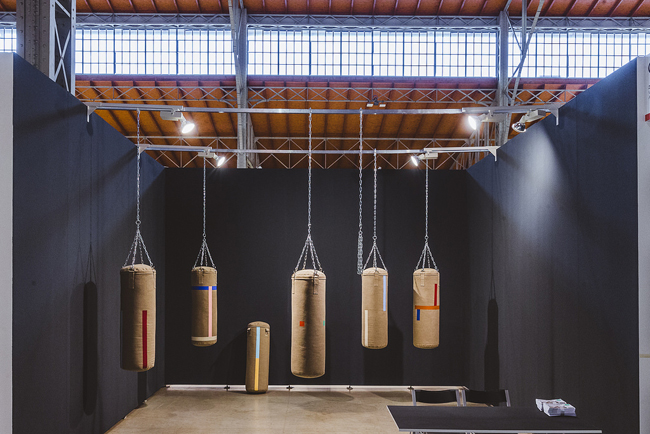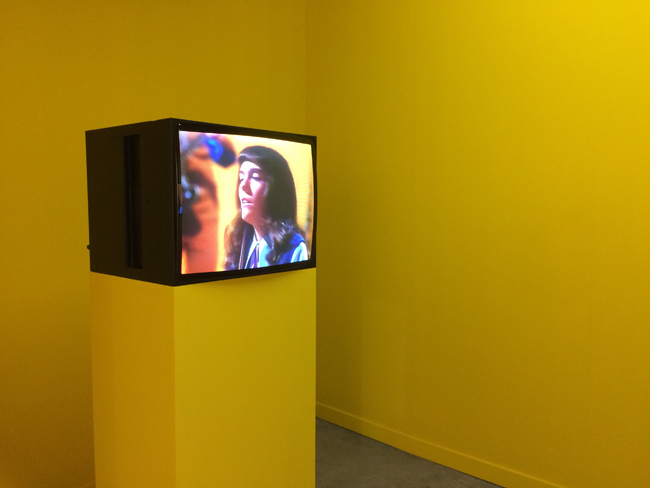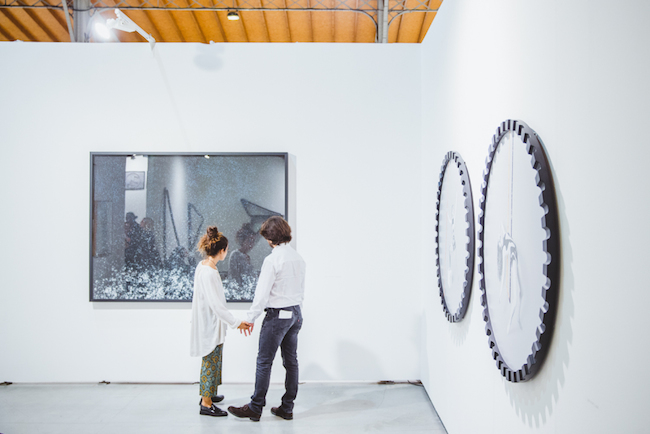
A look back at viennacontemporary 2017
30/09/2017
29,767 visitors – the official data coming from the organizers of viennacontemporary 2017 indicate that this year the fair has surpassed its own expectations, and, that in large part, it has fortified its position in the international art arena. From September 21 to 24 the art fair gathered together galleries, curators, artists, collectors and art lovers, thereby earmarking Vienna as an influential destination for contemporary art. Declaring at a press conference that the viennacontemporary’s goal is to become the fifth most important art fair in Europe, this year the event presented 110 galleries and art institutions from 27 countries, featuring the works of more than 500 artists.

Photo: viennacontemporary
Special attention at viennacontemporary 2017 was given to Hungary’s art scene and the neo-avant-garde artists of the 1970s – in direct contradiction to the restrictions put in place by the communist regime of the time, these artists were open to Western art trends and rocked Hungary’s art community with protestations, conceptual photography, “mail art”, and other means. The exposition, put together by art historian and critic József Mélyi and three private Budapest galleries – acb, Kisterem, and Vintage Galeria – gave viewers the opportunity to see a whole decade’s worth of Hungarian art, and once again, served as a reminder of the still yet-to-be-fully-appreciated place of Eastern European art in the global artscape.
ARCHIVE:
A look back at viennacontemporary 2016
A look back at viennacontemporary 2015
Christina Steinbrecher-Pfandt, artistic director of the fair, revealed that choosing a thematic focus and then working on it usually takes several years. In this case, the choice to put the spotlight on Hungarian art was a decision that was made four years ago. We were unable to find out who or what will be in the limelight at next year’s fair, but Steinbrecher-Pfandt did not hide the fact that the Baltic art scene is a sure future contender.
Looking back at the accomplishments of this year’s viennacontemporary and comparing it to those of previous years, Steinbrecher-Pfandt admits: “In terms of its structure, when we began this endeavor in 2012, people wondered if such a fair in Vienna could be viable; they were doubtful that it could be successful...that it would fulfill its objectives. People participated with the assumption that it would be a one-time thing. Now the number of collectors coming here is increasing with every year, and the galleries are becoming more involved in thinking about what they want to show here. They see what kind of art is worth showing here, and they understand who is coming to the fair. They’re bringing increasingly bigger works, and more qualitative works, too. In terms of sales, up to now I’ve met happy gallerists and happy collectors...so there is also progress in this context.”
Although the fair has yet to release the official sales numbers, Arterritory did meet several gallery representatives and artists who acknowledged successful business dealings, among them the Riga gallery Māksla XO. Having presented works by Paulis Liepa in their stand, the gallery was rather pleased with the results they achieved.

Galerie Thaddaeus Ropac, Salzburg/Paris/London. © Photo: viennacontemporary, A. Murashkin
It should be noted that the range in prices at the fair was quite broad. One could see in the booths of Austria’s leading galleries works by famous top-notch artists – sculptures by Antony Gormley and Anish Kapoor, works by Kader Attia, Marina Abramović, and Yayoi Kusama – and accordingly, prices that matched their makers’ star rankings. But right next to them one could also see booths of smaller galleries with much more grounded prices. A great factor in the discrepancies was due to the many works by emerging artists – a whole section of the fair, ZONE 1, was devoted to art created by Austria’s young and emerging artists, not to mention the fact that many galleries from other countries had also decided to feature art by new artists.

Gallery Zeller van Almsick, Vienna. © Photo: viennacontemporary, A. Murashkin
The quality of this year’s edition of the fair
In our surveying of the fair’s participants and visitors, the overwhelming majority spoke positively about the increase in quality of the 2017 fair. For instance, Ursula Krinzinger, director of Vienna’s Galerie Krinzinger and a member of the viennacontemporary admissions committee, described the fair as being much more elegant this year; she also placed emphasis on the Hungarian galleries which were invited to the Focus section of the fair: “Hungary’s galleries have created a fantastic, informative stand that displayed truly excellent works, in addition to having a perfect exposition.” Another vocal admirer of the Focus exposition was Vienna’s Hans Knoll, the director of Knoll Gallerie and an agent for several Hungarian artists.

György Galántai. Highway Sign Group, 1975. Vintage Galeria, Budapest. Focus Hungary at viennacontemporary
Latvian art collector Jānis Zuzāns concured that the fair showed showcased good-level art that is worth collecting: “This is an art fair for real collectors; it’s not for people who are only interested in name recognition or who just want to achieve the status of being ‘a collector’. This is the real environment in which to start a collection...where to develop it, and to live with it.”
Māris Vītols, another Latvian collector, believes that one of the keys that made this year’s fair a success was the presence of all of Austria’s best art galleries. Another key, and one that has proven its value over a number of years, was “the focus on one single country from the Eastern European region. This year’s presentation of Hungarian art, which included both today’s art scene and the post-war conceptualists, was a winner. I was pleasantly surprised by the Hungarian art and the quality of their galleries. The level of quality in the art at this fair has also become more uniform. Admittedly, it wasn’t so just three or four years ago. As a collector, this is a great opportunity for me to see, in one place, all of the latest art coming from Central and Eastern Europe. Since these countries are at the focus of our collection, this fair is an annual mainstay of our schedule.”
The artist and photographer Marina Faust expressed that this year’s viennacontemporary “had a good international energy. The quality of works was high, and I liked the fair much better than last year’s. I feel that viennacontemporary has found its place and it has finally taken root. The Talks Program was very good, and the food was also better this year, which is very important. Overall, it seems to me that this fair rose one level higher, and I hope it will continue in this manner. Vienna needs it.”

Candice Breitz. Double Karen (Close to You), 1970-2000. From series Duets, 2000. Gallery KOW, Berlin. Photo: Odrija Fišere

Works by Przemek Matecki. Raster Gallery, Warsaw. Photo:
On variety
While Laura Rutkutė from Vartai gallery in Vilnius applauded the galleries’ attempts at diversifying and standing out from one another, Ilze Žeivate, director of the Riga gallery Māksla XO, noticed that the offerings of the galleries from Central and Eastern Europe didn’t differ much from those of the Austrian galleries: “Some of the Eastern and Central European bloc countries try to be conceptually Viennese or Austrian. In my opinion, this super-minimalism, with its little papers and a couple of rods, has become a bit boring. The market changes. Galleries don’t have to be shy with their stands – they can allow themselves to be unabashedly baroque, rich with good paintings, huge photographs, or sculptures.” Dr. Matthias Röder, the director of the Eliette and Herbert von Karajan Institute, also appreciates the fair’s variety: “I’m interested in the use of technology in the creative fields, and I’m happy that I can observe that here.”

Photo: viennacontemporary
The collectors
In speaking about the presence of collectors at the fair, Ursula Krinzinger notes: “About 250 international collectors were invited to this year’s fair. Vienna is a fascinating city, and the collectors spend a large part of their time in the city itself. We have to work more on making them want to return to the fair again and again after having visited the city. Of course, that is an ethical question that the collectors have to deal with themselves – have they come here to spend a lovely weekend in Vienna and just pop into the fair for a few hours, or are they more serious? We all have to learn how to make the fair the best of the best.”

Gallery ŻAK | BRANICKA, Berlin © Photo: viennacontemporary, A. Murashkin
On the fair’s focus
Volker Diehl, the director of Diehl Gallery, appreciates the fair’s concept: “It is clear and powerful: to unite Western Europe with Eastern Europe. And I think that due to Vienna’s geographical location, it is also the ideal place to do that. At viennacontemporary it’s possible to meet artists and see art that you wouldn’t see anywhere else.” Laura Rutkutė reminds us, however, that some countries, such as Poland, aren’t well represented at the fair.
Arterritory.com also noticed that, even though viennacontemporary continues to position itself as an art fair dedicated to art from Eastern and Central Europe, the obvious majority of galleries presenting there are from Austria and Germany. Austrian galleries numbered close to forty, while German ones were about twenty or so. This leads one to wonder if the fair is perhaps veering away from its original intentions, and leaving the Eastern European art market by the wayside again.
Photographer Marina Faust, however, thinks that “the idea of focusing on Eastern Europe is a good one, but the fair should show art from other countries as well, as it did this time.”

Estonian artist Anu Vahtra at Budapest’s Chimera-Project Gallery. This year artist received the viennacontemporary’s Artproof Photo Award 2017. Photo:
“The fair has managed to maintain its attractiveness by positioning itself as a unifying factor that could try to merge two groups of collectors – those who are interested in art from Western countries, and those who are interested in art from Central and Eastern Europe,” remarks art collector Māris Vītols. “In my opinion, it perfectly corresponds to the political ambitions of Austria as a state, which is to be a unifying space in this region. That’s why this concept is so very easy to understand, and why it functions so well.” He believes that progress can also be seen in the way that the art scene has become more integrated. “If we look back at the Vienna fair five or six years ago, there were clearly delineated zones – ones for Austrian art galleries, which usually only local art collectors would go to, and then a separate zone for Central and Eastern European galleries. This year the Austrian galleries have been interspersed with those of other countries, which makes for a more coordinated and unifying overview of the art.”

Gallery Croy Nielsen, Vienna. © Photo: viennacontemporary, A. Murashkin
The future of the fair
Slovenian independent curator Tevž Logar, who curated the Bucharest gallery’s presentation at this year’s fair, opined the following on the subject of regional art fairs: “The former countries of Yugoslavia have an excellent art legacy from the 1950s to 70s, their new generation artists have been internationally noticed, and there is potential to continue making good art. However, we have a poorly developed gallery network. There are people in the region who have money, but not many are ready to invest it in contemporary art. If all three of these elements – qualitative art, sellers, and buyers – were in balance, I believe that regional fairs would have a future. If these elements are not in balance, I just don’t see the point of a regional fair.” Art collector Jānis Zuzāns notes the democratic nature of the new fairs: “Not every gallery can afford to spend large amounts in order to get into the grandiose art fairs like Art Basel or Frieze in London. These fairs have different circumstances, different requirements. In this sense, viennacontemporary is a good alternative.” Volker Diehl of Diehl Gallery predicts the future of regional and niche fairs so: “Paris Photo, the fair dedicated to photography, or fairs that focus on drawings and works on paper – I think that those have a future. If it’s a fair that wants to resemble the big shots by simply copying them, then it no longer has a unique face and it becomes uninteresting.” On this theme of the future of art fairs, Dr. Matthias Röder declares: “After witnessing the wave of globalization and internationalization that has taken place in the last few years, not only in business but also in various aspects of social life, right now one can observe the trend of people beginning to show an interest in the regional again. They’re beginning to delve into the different and the exceptional within regions, which is why I believe that this sort of a fair has a future.”
Ursula Krinzinger admits that this is a difficult question that she poses to herself almost every day: “At first my gallery participated only in large and professional art fairs, but after a while we decided to also take part in smaller and regional fairs; however, now there are so many of them… I’m beginning to doubt that this is the right road to take, but I have yet to make a final judgement.”

Focus Hungary. © Photo: viennacontemporary, A. Murashkin
Gallerist Hans Knoll, on the other hand, has the opposite opinion concerning regional art fairs: “Looking at the fairs in Bucharest or Budapest, it’s clear that they cannot be successful. They are like a burden to my colleagues because there they meet only collectors that they already know due to the narrow circle of art collectors in the region. New collectors – from New York, Paris, Brussels, or anywhere else, for that matter – do not show up to these mid-level fairs because they have to choose among the more than 300 fairs being held throughout the world.” Nevertheless, Knoll does not count viennacontemporary as a regional fair: “This fair is larger and more ambitious. It’s growing and developing, but it should be more international nevertheless.” Knoll gives the fair good marks for how it handled its tasks this year – the fair’s organizers have successfully brought to Vienna visitors, journalists, and even collectors from Hungary. “Here Hungarian galleries and artists can meet Austrian and international viewers and collectors, which is something that doesn’t happen in, for instance, Budapest or Bucharest.”

The southern end of the Upper Belvedere hosts one of Erwin Wurm's famous fat houses - Fat House, 2003. Photo:
The background of Vienna’s art life
As Christina Steinbrecher-Pfandt said, during the weekend of viennacontemporary the city of Vienna offers more than 200 events geared to art and culture enthusiasts. According to your proclivities and endurance, you could dive into a flood of activities and happenings and just go where the current takes you – to museum openings, discussions, art tours, etc. Timing their schedules to the art fair, museums, curators and artists created events with the aim of showing their best. Much in the same way, Vienna’s collectors also opened the doors to their collections. Hans Knoll enlightened us to the fact that Vienna, a city of less than two million, hosts eight to nine art fairs a year, and a brand-new contemporary art fair has just appeared. The art market industry is growing, as is the number of Vienna’s art galleries – new local initiatives are popping up, and many foreign galleries (mostly from German cities, but also from Istanbul and elsewhere) are opening up subsidiary spaces in the Austrian capital. “In that sense, the ‘cake’ is becoming ever larger – the galleries that come here and stay here create new collectors. I’m just wondering if all of these fairs are also creating new collectors…,” comments Hans Knoll.
ARCHIVE: A report from the viennacontemporary international contemporary art fair

Photo: viennacontemporary

Photo: viennacontemporary